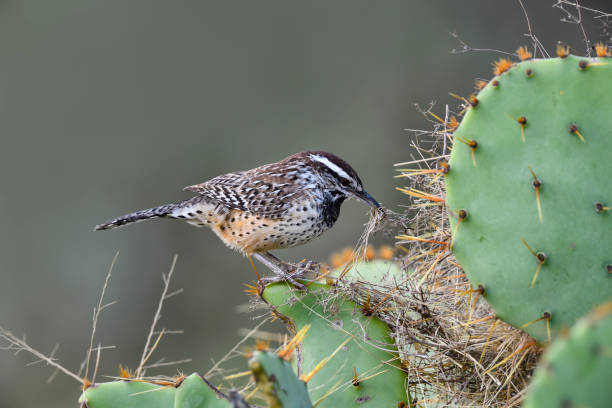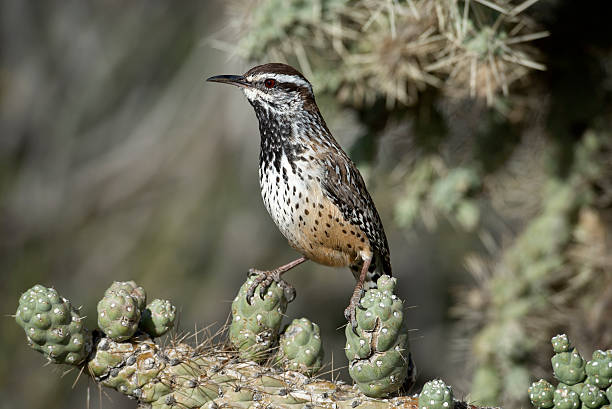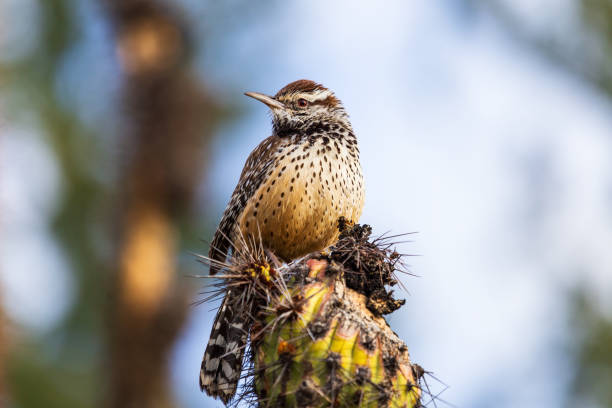Table of Contents
Scientific Classification
| Kingdom | Animalia |
| Phylum | Chordata |
| Class | Aves |
| Order | Passeriformes |
| Family | Troglodytidae |
| Genus | Campylorhynchus |
| Species | C. brunneicapillus |
| Scientific Name | Campylorhynchus brunneicapillus |
1. Description
The Cactus Wren is a delightful and spirited bird, known for being the largest wren in North America. With its sturdy body and impressively long tail, this wren is quite a sight against the backdrop of the dry desert landscapes it inhabits. Its feathers boast a beautiful blend of earthy tones, featuring a brown top adorned with white streaks, while its creamy white belly is dotted with black spots. A striking white eyebrow line, known as a supercilium, runs above its eyes, creating a bold contrast that makes the Cactus Wren easily identifiable, even from afar.
Measuring between 7 to 9 inches (18–23 cm) in length and weighing around 1.5 ounces (40 grams), this bird often dominates the soundscape of the desert with its loud, scolding calls. Its size and vocal presence truly set it apart!

2. Distribution
The Cactus Wren is found primarily in the southwestern United States and parts of Mexico. Its range includes:
- United States: Southern California, Arizona, New Mexico, and western Texas
- Mexico: Extending southward into central and northern Mexican deserts
It is very common in the Sonoran and Chihuahuan deserts. It thrives in the tough terrain and high heat.
3. Habitat
The Cactus Wren makes its home in the dry, prickly deserts, thriving in areas filled with cacti, yucca, mesquite, and various shrubs. It has a particular fondness for cholla and saguaro cacti, which not only provide food but also serve as perfect spots for nesting and perching.
You can also spot this bird in:
– Dry scrublands
– Desert grasslands
– Suburban areas featuring xeriscaping
Its ability to adapt to human-altered environments has allowed it to survive even as development encroaches on its natural habitat.

4. Diet
The Cactus Wren is quite the omnivore, and its menu changes depending on what’s available. Here’s what it typically munches on:
– Insects: Think ants, beetles, grasshoppers, and caterpillars
– Spiders and other little critters
– Fruits and berries: Like prickly pear fruit and mesquite pods
– Occasionally, they might snack on small reptiles or even bird eggs
These clever birds usually hunt for food on the ground. They hop around, flipping over leaves and rocks in search of a tasty treat. Resourceful little creatures, they’ll even peck open insect nests to get to their meal!

5. Behavior
- Cactus Wrens are lively, territorial little birds with a curious nature. They’re quite bold and often let people get surprisingly close. You’ll notice their animated movements—hopping around, flicking their tails, and tilting their heads as they explore their environment.
- Here are some key behaviors:
- – Monogamy: These birds form strong bonds, sticking together as a pair all year long.
- – Vocalization: Their loud, raspy calls are not just for show; they use them to defend their territory and communicate with their partners.
- – Territoriality: Cactus Wrens are fiercely protective of their space and can be quite aggressive toward any intruders.
- – Ground Foraging: Unlike some birds that prefer the trees, Cactus Wrens often search for food right on the ground.
6. Lifespan
Cactus Wrens typically have a lifespan of about 7 years in the wild. Unfortunately, many of them don’t make it that long because of predators and the challenges posed by their environment. However, in captivity or under perfect conditions, they can live even longer!
7. Reproduction and Lifecycle
Cactus Wrens typically breed from late March through early July, often raising two to three broods each season.
Courtship:
The male showcases a captivating song display, and once a pair forms a bond, they stick together for life.
Nesting:
Females build large, football-shaped nests with a side entrance. You can usually find these nests in cholla cacti, thorny shrubs, or trees, which offer excellent protection from predators.
Eggs & Chicks:
Clutch size: 3–6 eggs
The eggs are pale with speckles.
Incubation: 16 days (mainly by the female)
Fledging: The chicks leave the nest around 18 days old but continue to hang around their parents for a few more weeks.
The parents are incredibly attentive, actively feeding and fiercely defending their little ones.

8. Predators
Cactus Wrens are known for their spiky nests, but they have to be on high alert for a variety of predators, especially when they’re nesting. They face threats from snakes like coachwhips and gopher snakes, as well as birds of prey such as hawks and owls. Mammals, including coyotes, raccoons, and even domestic cats, also pose a danger. While these nests are cleverly built in hard-to-reach places, determined predators can still find a way to threaten them.
9. Adaptations
Living in a harsh desert environment has shaped several key adaptations:
- Desert Heat Resistance: They can handle high temperatures and seldom drink water. Instead, they get moisture from their food.
- Nest Structure: Enclosed nests shield eggs from sun and predators
- Cactus Defense: Building nests among spines deters predators
- Bold Behavior: Aggression and loud calls help defend territory and young
These adaptations help them not just survive, but thrive in an unforgiving environment.
10. Conservation Status
The Cactus Wren is classified as Least Concern by the IUCN. Its population is stable in most areas, but some local threats exist:
- Habitat Loss: Due to urban development and invasive plant species
- Wildfires: Can destroy large patches of nesting habitat
- Climate Change: May alter desert ecosystems over time
Conservation groups monitor populations in more urbanized areas to ensure sustainable numbers.
11. Nest
One of the most fascinating features of the Cactus Wren is its nest. The side entrance opens to a soft, feather-lined space that keeps eggs and chicks safe.
Wrens often build multiple nests, using some for roosting and others for breeding. Old nests may be reused in successive seasons.
12. Call
The Cactus Wren’s call is easy to recognise. It sounds like a harsh, quick “char-char-char,” similar to a sewing machine. These vocalizations serve multiple purposes:
- Territory Defense
- Mate Communication
- Alarm Calls when predators are near
They are loud and unmissable, making these birds the most vocal denizens of the desert.
13. Interesting Facts
- State Bird: The Cactus Wren is the official state bird of Arizona
- Multiple Nests: They sometimes build up to six nests, using extras as decoys
- Resilience: Can survive weeks without free-standing water, relying on metabolic water from insects
- Cooperative Chores: Males help feed chicks and may even help with nest construction
- Urban Adaptability: They often build homes in backyard cacti and on utility poles in desert towns.

Final Thoughts
The Cactus Wren thrives in the desert. It’s a bold, busy bird. Each trait, from its speckled feathers to its harsh song, shows its dry habitat. Its lively presence in the desert ecosystems of the American Southwest brings texture, life, and sound to landscapes that might seem quiet. As climate and human growth change our world, birds like the Cactus Wren display nature’s strength and beauty. They keep adapting and enduring.


